Claudio Ferrari
3D Face Reconstruction Error Decomposed: A Modular Benchmark for Fair and Fast Method Evaluation
May 23, 2025Abstract:Computing the standard benchmark metric for 3D face reconstruction, namely geometric error, requires a number of steps, such as mesh cropping, rigid alignment, or point correspondence. Current benchmark tools are monolithic (they implement a specific combination of these steps), even though there is no consensus on the best way to measure error. We present a toolkit for a Modularized 3D Face reconstruction Benchmark (M3DFB), where the fundamental components of error computation are segregated and interchangeable, allowing one to quantify the effect of each. Furthermore, we propose a new component, namely correction, and present a computationally efficient approach that penalizes for mesh topology inconsistency. Using this toolkit, we test 16 error estimators with 10 reconstruction methods on two real and two synthetic datasets. Critically, the widely used ICP-based estimator provides the worst benchmarking performance, as it significantly alters the true ranking of the top-5 reconstruction methods. Notably, the correlation of ICP with the true error can be as low as 0.41. Moreover, non-rigid alignment leads to significant improvement (correlation larger than 0.90), highlighting the importance of annotating 3D landmarks on datasets. Finally, the proposed correction scheme, together with non-rigid warping, leads to an accuracy on a par with the best non-rigid ICP-based estimators, but runs an order of magnitude faster. Our open-source codebase is designed for researchers to easily compare alternatives for each component, thus helping accelerating progress in benchmarking for 3D face reconstruction and, furthermore, supporting the improvement of learned reconstruction methods, which depend on accurate error estimation for effective training.
U-Shape Mamba: State Space Model for faster diffusion
Apr 18, 2025Abstract:Diffusion models have become the most popular approach for high-quality image generation, but their high computational cost still remains a significant challenge. To address this problem, we propose U-Shape Mamba (USM), a novel diffusion model that leverages Mamba-based layers within a U-Net-like hierarchical structure. By progressively reducing sequence length in the encoder and restoring it in the decoder through Mamba blocks, USM significantly lowers computational overhead while maintaining strong generative capabilities. Experimental results against Zigma, which is currently the most efficient Mamba-based diffusion model, demonstrate that USM achieves one-third the GFlops, requires less memory and is faster, while outperforming Zigma in image quality. Frechet Inception Distance (FID) is improved by 15.3, 0.84 and 2.7 points on AFHQ, CelebAHQ and COCO datasets, respectively. These findings highlight USM as a highly efficient and scalable solution for diffusion-based generative models, making high-quality image synthesis more accessible to the research community while reducing computational costs.
$^R$FLAV: Rolling Flow matching for infinite Audio Video generation
Mar 12, 2025Abstract:Joint audio-video (AV) generation is still a significant challenge in generative AI, primarily due to three critical requirements: quality of the generated samples, seamless multimodal synchronization and temporal coherence, with audio tracks that match the visual data and vice versa, and limitless video duration. In this paper, we present $^R$-FLAV, a novel transformer-based architecture that addresses all the key challenges of AV generation. We explore three distinct cross modality interaction modules, with our lightweight temporal fusion module emerging as the most effective and computationally efficient approach for aligning audio and visual modalities. Our experimental results demonstrate that $^R$-FLAV outperforms existing state-of-the-art models in multimodal AV generation tasks. Our code and checkpoints are available at https://github.com/ErgastiAlex/R-FLAV.
Spatio-temporal Transformers for Action Unit Classification with Event Cameras
Oct 29, 2024



Abstract:Face analysis has been studied from different angles to infer emotion, poses, shapes, and landmarks. Traditionally RGB cameras are used, yet for fine-grained tasks standard sensors might not be up to the task due to their latency, making it impossible to record and detect micro-movements that carry a highly informative signal, which is necessary for inferring the true emotions of a subject. Event cameras have been increasingly gaining interest as a possible solution to this and similar high-frame rate tasks. We propose a novel spatiotemporal Vision Transformer model that uses Shifted Patch Tokenization (SPT) and Locality Self-Attention (LSA) to enhance the accuracy of Action Unit classification from event streams. We also address the lack of labeled event data in the literature, which can be considered one of the main causes of an existing gap between the maturity of RGB and neuromorphic vision models. Gathering data is harder in the event domain since it cannot be crawled from the web and labeling frames should take into account event aggregation rates and the fact that static parts might not be visible in certain frames. To this end, we present FACEMORPHIC, a temporally synchronized multimodal face dataset composed of RGB videos and event streams. The dataset is annotated at a video level with facial Action Units and contains streams collected with various possible applications, ranging from 3D shape estimation to lip-reading. We then show how temporal synchronization can allow effective neuromorphic face analysis without the need to manually annotate videos: we instead leverage cross-modal supervision bridging the domain gap by representing face shapes in a 3D space. Our proposed model outperforms baseline methods by effectively capturing spatial and temporal information, crucial for recognizing subtle facial micro-expressions.
Beyond Fixed Topologies: Unregistered Training and Comprehensive Evaluation Metrics for 3D Talking Heads
Oct 14, 2024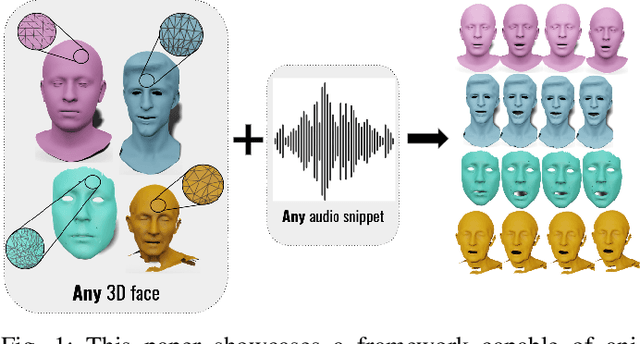
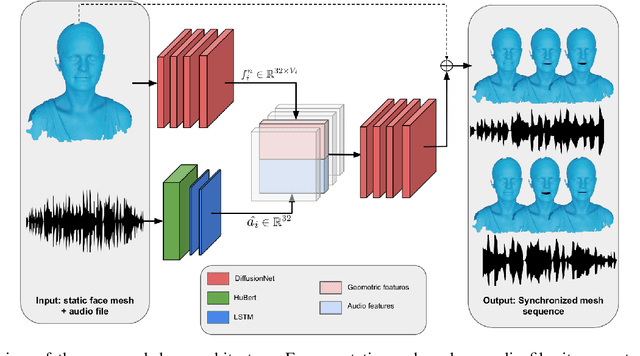
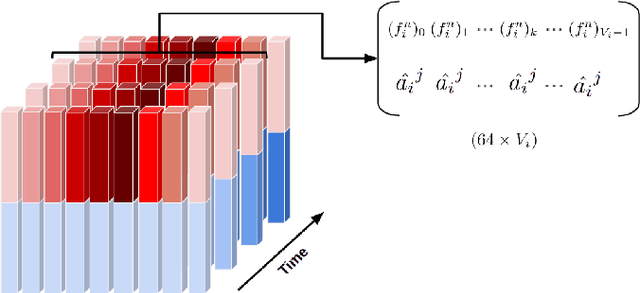
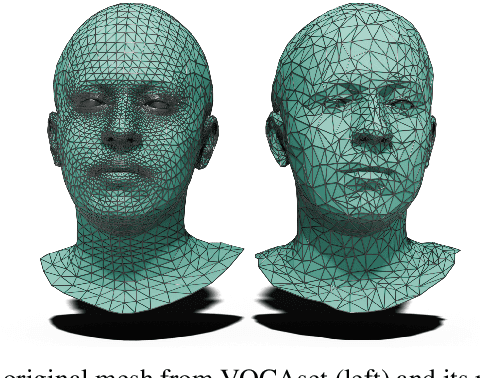
Abstract:Generating speech-driven 3D talking heads presents numerous challenges; among those is dealing with varying mesh topologies. Existing methods require a registered setting, where all meshes share a common topology: a point-wise correspondence across all meshes the model can animate. While simplifying the problem, it limits applicability as unseen meshes must adhere to the training topology. This work presents a framework capable of animating 3D faces in arbitrary topologies, including real scanned data. Our approach relies on a model leveraging heat diffusion over meshes to overcome the fixed topology constraint. We explore two training settings: a supervised one, in which training sequences share a fixed topology within a sequence but any mesh can be animated at test time, and an unsupervised one, which allows effective training with varying mesh structures. Additionally, we highlight the limitations of current evaluation metrics and propose new metrics for better lip-syncing evaluation between speech and facial movements. Our extensive evaluation shows our approach performs favorably compared to fixed topology techniques, setting a new benchmark by offering a versatile and high-fidelity solution for 3D talking head generation.
Mamba-ST: State Space Model for Efficient Style Transfer
Sep 16, 2024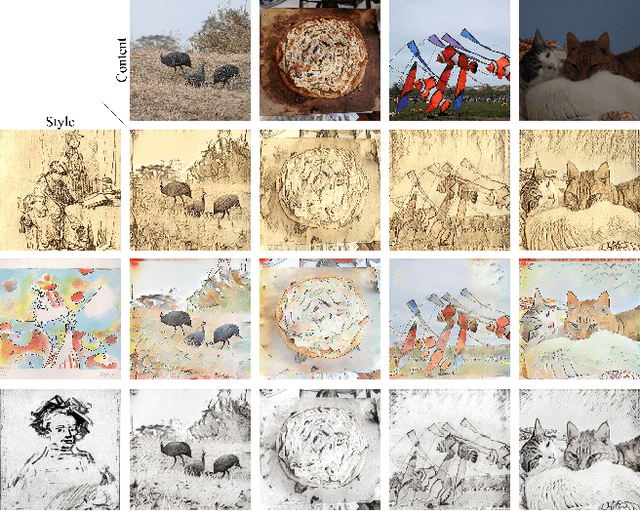

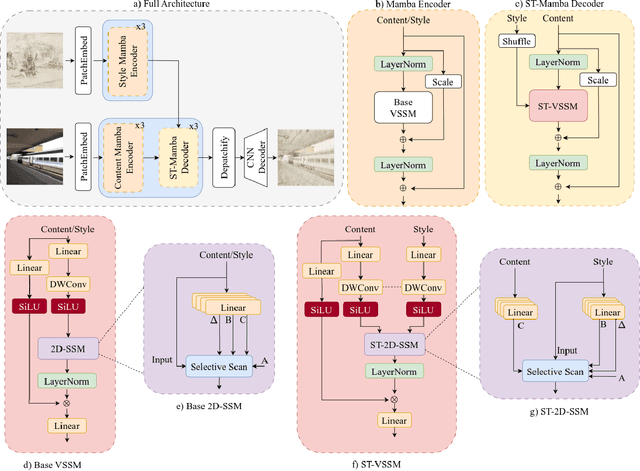

Abstract:The goal of style transfer is, given a content image and a style source, generating a new image preserving the content but with the artistic representation of the style source. Most of the state-of-the-art architectures use transformers or diffusion-based models to perform this task, despite the heavy computational burden that they require. In particular, transformers use self- and cross-attention layers which have large memory footprint, while diffusion models require high inference time. To overcome the above, this paper explores a novel design of Mamba, an emergent State-Space Model (SSM), called Mamba-ST, to perform style transfer. To do so, we adapt Mamba linear equation to simulate the behavior of cross-attention layers, which are able to combine two separate embeddings into a single output, but drastically reducing memory usage and time complexity. We modified the Mamba's inner equations so to accept inputs from, and combine, two separate data streams. To the best of our knowledge, this is the first attempt to adapt the equations of SSMs to a vision task like style transfer without requiring any other module like cross-attention or custom normalization layers. An extensive set of experiments demonstrates the superiority and efficiency of our method in performing style transfer compared to transformers and diffusion models. Results show improved quality in terms of both ArtFID and FID metrics. Code is available at https://github.com/FilippoBotti/MambaST.
Neuromorphic Facial Analysis with Cross-Modal Supervision
Sep 16, 2024



Abstract:Traditional approaches for analyzing RGB frames are capable of providing a fine-grained understanding of a face from different angles by inferring emotions, poses, shapes, landmarks. However, when it comes to subtle movements standard RGB cameras might fall behind due to their latency, making it hard to detect micro-movements that carry highly informative cues to infer the true emotions of a subject. To address this issue, the usage of event cameras to analyze faces is gaining increasing interest. Nonetheless, all the expertise matured for RGB processing is not directly transferrable to neuromorphic data due to a strong domain shift and intrinsic differences in how data is represented. The lack of labeled data can be considered one of the main causes of this gap, yet gathering data is harder in the event domain since it cannot be crawled from the web and labeling frames should take into account event aggregation rates and the fact that static parts might not be visible in certain frames. In this paper, we first present FACEMORPHIC, a multimodal temporally synchronized face dataset comprising both RGB videos and event streams. The data is labeled at a video level with facial Action Units and also contains streams collected with a variety of applications in mind, ranging from 3D shape estimation to lip-reading. We then show how temporal synchronization can allow effective neuromorphic face analysis without the need to manually annotate videos: we instead leverage cross-modal supervision bridging the domain gap by representing face shapes in a 3D space.
MARS: Paying more attention to visual attributes for text-based person search
Jul 05, 2024Abstract:Text-based person search (TBPS) is a problem that gained significant interest within the research community. The task is that of retrieving one or more images of a specific individual based on a textual description. The multi-modal nature of the task requires learning representations that bridge text and image data within a shared latent space. Existing TBPS systems face two major challenges. One is defined as inter-identity noise that is due to the inherent vagueness and imprecision of text descriptions and it indicates how descriptions of visual attributes can be generally associated to different people; the other is the intra-identity variations, which are all those nuisances e.g. pose, illumination, that can alter the visual appearance of the same textual attributes for a given subject. To address these issues, this paper presents a novel TBPS architecture named MARS (Mae-Attribute-Relation-Sensitive), which enhances current state-of-the-art models by introducing two key components: a Visual Reconstruction Loss and an Attribute Loss. The former employs a Masked AutoEncoder trained to reconstruct randomly masked image patches with the aid of the textual description. In doing so the model is encouraged to learn more expressive representations and textual-visual relations in the latent space. The Attribute Loss, instead, balances the contribution of different types of attributes, defined as adjective-noun chunks of text. This loss ensures that every attribute is taken into consideration in the person retrieval process. Extensive experiments on three commonly used datasets, namely CUHK-PEDES, ICFG-PEDES, and RSTPReid, report performance improvements, with significant gains in the mean Average Precision (mAP) metric w.r.t. the current state of the art.
Adversarial Identity Injection for Semantic Face Image Synthesis
Apr 16, 2024Abstract:Nowadays, deep learning models have reached incredible performance in the task of image generation. Plenty of literature works address the task of face generation and editing, with human and automatic systems that struggle to distinguish what's real from generated. Whereas most systems reached excellent visual generation quality, they still face difficulties in preserving the identity of the starting input subject. Among all the explored techniques, Semantic Image Synthesis (SIS) methods, whose goal is to generate an image conditioned on a semantic segmentation mask, are the most promising, even though preserving the perceived identity of the input subject is not their main concern. Therefore, in this paper, we investigate the problem of identity preservation in face image generation and present an SIS architecture that exploits a cross-attention mechanism to merge identity, style, and semantic features to generate faces whose identities are as similar as possible to the input ones. Experimental results reveal that the proposed method is not only suitable for preserving the identity but is also effective in the face recognition adversarial attack, i.e. hiding a second identity in the generated faces.
EmoVOCA: Speech-Driven Emotional 3D Talking Heads
Mar 19, 2024



Abstract:The domain of 3D talking head generation has witnessed significant progress in recent years. A notable challenge in this field consists in blending speech-related motions with expression dynamics, which is primarily caused by the lack of comprehensive 3D datasets that combine diversity in spoken sentences with a variety of facial expressions. Whereas literature works attempted to exploit 2D video data and parametric 3D models as a workaround, these still show limitations when jointly modeling the two motions. In this work, we address this problem from a different perspective, and propose an innovative data-driven technique that we used for creating a synthetic dataset, called EmoVOCA, obtained by combining a collection of inexpressive 3D talking heads and a set of 3D expressive sequences. To demonstrate the advantages of this approach, and the quality of the dataset, we then designed and trained an emotional 3D talking head generator that accepts a 3D face, an audio file, an emotion label, and an intensity value as inputs, and learns to animate the audio-synchronized lip movements with expressive traits of the face. Comprehensive experiments, both quantitative and qualitative, using our data and generator evidence superior ability in synthesizing convincing animations, when compared with the best performing methods in the literature. Our code and pre-trained model will be made available.
 Add to Chrome
Add to Chrome Add to Firefox
Add to Firefox Add to Edge
Add to Edge